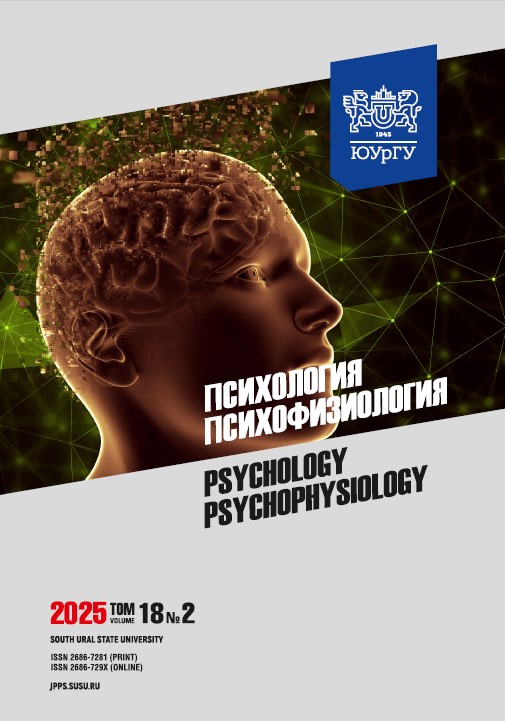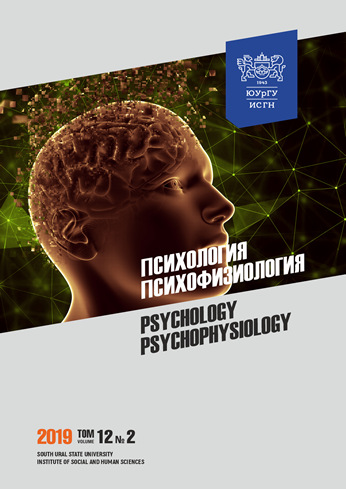Prognostically unfavorable clinical and psychopathological factors in first-episode psychosis
Abstract
Introduction. The clinical heterogeneity of schizophrenic spectrum disorders demonstrates a direct relationship between prognostically unfavorable clinical and psychopathological factors and low treatment efficacy. Emerging evidence suggests that these factors may exert greater detrimental effects than the psychopathological structure of the disorder itself. Aims. This prospective study aimed to analyze the association between the severity, psychotic structure, and course of first-episode psychosis (FEP) and adverse clinical and psychopathological predictors, informing the development of the IMPULSE psychosocial rehabilitation program. Materials and methods. The study enrolled 79 male FEP patients from the First-Episode Psychosis Unit (Regional Clinical Specialized Neuropsychiatric Hospital, Chelyabinsk, Russia). Results. Statistical analysis demonstrated significant correlations between clinical and psychopathological factors and FEP course. The most unfavorable predictors included the absence of established family, negative familial attitude toward illness and unemployment at admission. Patients with social decline showed higher rates of autistic features and repeated hospitalizations. Patients with antisocial behaviors were characterized by repeated hospitalizations, involuntary hospitalizations, aggressive/self-harm behaviors, psychopathic traits, and suicidal tendencies. Unstable remission and repeated seizures were associated with repeated hospitalizations, psychopathic behavior and severe imperative/hostile pseudohallucinations. These findings enable early identification and inform targeted interventions to modify disease trajectory, optimizing treatment strategies and psychosocial rehabilitation approaches. Conclusion. The identification of adverse clinical and psychopathological factors enables accurate determination of illness trajectory and progression patterns in FEP within schizophrenic spectrum disorders. Early intervention targeting these modifiable prognostic factors may prevent unfavorable disease outcomes, thereby optimizing clinical management strategies and enhancing the effectiveness of rehabilitation programs.
Downloads
References
2. Kachaeva M.A., Shport S.V., Trushchelev S.A. WHO Strategic Directions For The Protection Of Mental Health. Rossiiskii psikhiatricheskii zhurnal = Russian Journal of Psychiatry. 2017;6:10–23.
(in Russ.).
3. Skugarevskii O.A., Skugarevskaya M.M. Vozmozhnosti rannei diagnostiki i profilaktiki psikhozov. Vestnik psikhiatrii i psikhologii Chuvashii = The Bulletin of Chuvash Psychiatry and Psychology 2015;2:10–25. (in Russ.)
4. Colizzi M., Lasalvia A., Ruggeri M. Prevention and early intervention in youth mental health: is it time for a multidisciplinary and trans-diagnostic model for care? International journal of mental health systems. 2020;14:1–14. DOI: 10.1186/s13033-020-00356-9.
5. Fusar-Poli P., Correll U., Arango C. et al. Preventive psychiatry: a blueprint for improving the mental health of young people. World Psychiatry. 2021;20(2):200–221. DOI: 10.1002/wps.20869.
6. Chinarev V.A. Clinical, Functional and Personal Recovery as a Guideline in the Rehabilitation of Patients Who Have Suffered a First Psychotic Episode. Mezhdunarodnyi nauchno-issledovatelskii zhurnal = International Scientific Research Journal. 2024;9(147). (in Russ.). DOI: 10.60797/IRJ.2024.147.86.
7. Rasmus P., Lipert A., Pękala K. et al. The influence of a psychosocial rehabilitation program in a community health setting for patients with chronic mental disorders. International journal of environmental research and public health. 2021;18(8):4319. DOI: 10.3390/ijerph18084319.
8. Chinarev V.A., Malinina E.V. The First Psychotic Episode: Clinical, Diagnostic Aspects, and Therapeutic Approaches. Doktor.Ru. 2024;23:102–112. (in Russ.). DOI: 10.31550/1727-2378-2024-23-7-102-112.
9. Shchetinina E.V. Cognitive and emotional-volitional deficits as targets for psychosocial rehabilitation of patients after the first psychotic episode. Psikhologiya. Psikhofiziologiya = Psychology. Psychophysiology. 2023;16(2):49–56.(in Russ.). DOI: 10.14529/jpps230205
10. Pochueva V.V., Kolykhalov I.V. Clinical and Psychopathological Features of Late-Onset Schizophrenia and Schizophrenia-Like Psychosis. Psikhiatriya = Psychiatry. 2023;21(6):31–41. (in Russ.). DOI: 10.30629/2618-6667-2023-21-6-31-41.
11. Shchetinina E.V., Shchelkova O.Yu., Chernov N.V., Kostyuk G.P. Clinical and Psychological Characteristics of Patients after First-Episode Psychosis with Cognitive, Emotional, and Volitional Deficiencies: Comparative Analysis. SibSkript. 2024;26(2):210–222. (in Russ.). DOI: 10.21603/sibscript-2024-26-2-210-222.
12. Kuznecov S.Yu., Kozhevnikova M.Yu., Movina L.G., Papsuev O.O. Dynamics of social cognition and apathy in patients with psychotic disorders during metacognitive training. Rossiiskii psikhiatricheskii zhurnal = Russian Journal of Psychiatry. 2020;6:55–61. (in Russ.). DOI: 10.24411/1560-957Kh-2020-10607.
13. Agranovskii M.L., Gulomkodirov M.M., Muminov R.K., Dalimova S.A. Distant stage of schizophrenia with a remitting type of course and disorders of the schizophrenic spectrum. Ekonomika i sotsium = Economics and society. 2022;6-2(97):289–292. (in Russ.).
14. Cupo L., McIlwaine S.V., Daneault J.G. et al. Timing, distribution, and relationship between nonpsychotic and subthreshold psychotic symptoms prior to emergence of a first episode of psychosis. Schizophrenia Bulletin. 2021;47(3):604–614. DOI: 10.1093/schbul/sbaa183.
15. Beards S., Fisher H.L., Gayer-Anderson Ch. et al. Threatening life events and difficulties and psychotic disorder. Schizophrenia Bulletin. 2020;46(4):814–822. DOI: 10.1093/schbul/sbaa005.
16. Drake R.J., Husain N., Marshall M. et al. Effect of delaying treatment of first-episode psychosis on symptoms and social outcomes: a longitudinal analysis and modelling study. The Lancet Psychiatry. 2020;7(7):602–610. DOI: 10.1016/S2215-0366(20)30147-4.
17. Catalan A., Richter A., Salazar de Pablo G. et al. Proportion and predictors of remission and recovery in first-episode psychosis: Systematic review and meta-analysis. European Psychiatry. 2021;64(1):e69. DOI: 10.1192/j.eurpsy.2021.2246.
18. Fusar-Poli P., Salazar de Pablo G., Rajkumar R.P. et al. Diagnosis, prognosis, and treatment of brief psychotic episodes: a review and research agenda. The Lancet Psychiatry. 2022;9(1):72–83. DOI: 10.1016/S2215-0366(21)00121-8.
19. Hansen H.G., Speyer H., Starzer M. et al. Clinical recovery among individuals with a first-episode schizophrenia an updated systematic review and meta-analysis. Schizophrenia Bulletin. 2023;49(2):297–308. DOI: 10.1093/schbul/sbac103.
20. Fulford D., Meyer-Kalos P.S., Mueser K.T. Focusing on recovery goals improves motivation in first-episode psychosis. Social psychiatry and psychiatric epidemiology. 2020;55:1629–1637. DOI: 10.1007/s00127-020-01877-x.
21. Lim K., Peh O.H., Yang Z. et al. Large-scale evaluation of the Positive and Negative Syndrome Scale (PANSS) symptom architecture in schizophrenia. Asian Journal of Psychiatry. 2021;62:102732. DOI: 10.1016/j.ajp.2021.102732.
22. Nielsen C.M., Kølbæk P., Dines D. et al. Validation of ratings on the six-item Positive and Ne¬gative Syndrome Scale obtained via the Simplified Negative and Positive Symptoms Interview among outpatients with schizophrenia. Journal of Psychopharmacology. 2022;36(11):1208–1217. DOI: 10.1177/02698811221131992.
23. Salvatore P., Baldessarini R.J., Khalsa H.K., Tohen M. Prodromal features in first-psychotic episodes of major affective and schizoaffective disorders. Journal of Affective Disor-ders. 2021;295:1251–1258. DOI: 10.1016/j.jad.2021.08.099.
24. Serra-Arumí C., Golay P., Bonnarel V. et al. Risk and protective factors for recovery at 3-year follow-up after first-episode psychosis onset: a multivariate outcome approach. Social psychiatry and psychiatric epidemiology. 2024;59(7):1255–1267. DOI: 10.1007/s00127-023-02579-w.
25. Provenzani U., Salazar de Pablo G., Arribas M. et al. Clinical outcomes in brief psychotic episodes: a systematic review and meta-analysis. Epidemiology and Psychiatric Sciences. 2021;30:e71. DOI: 10.1017/S2045796021000548.
References on translit
-Copyright (c) 2025 Psychology. Psychophysiology

This work is licensed under a Creative Commons Attribution-NonCommercial-NoDerivatives 4.0 International License.



